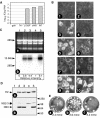Involvement of a bovine viral diarrhea virus NS5B locus in virion assembly
- PMID: 15331694
- PMCID: PMC515013
- DOI: 10.1128/JVI.78.18.9612-9623.2004
Involvement of a bovine viral diarrhea virus NS5B locus in virion assembly
Abstract
A novel mutant of bovine viral diarrhea virus (BVDV) was found with a virion assembly phenotype attributable to an insertion into the NS5B polymerase locus. This mutant, termed 5B-741, was engineered by reverse genetics to express NS5B with a C-terminal peptide tag of 22 amino acids. Electroporation of bovine cells with genomic RNA from this mutant showed levels RNA synthesis which were regarded as sufficient for infectivity, yet infectious virions were not produced. Pseudorevertants of mutant 5B-741 that released infectious virions and formed plaques revealed a single nucleotide change (T12369C). This change resulted in a leucine-to-proline substitution within the NS5B tag (L726P). Genetic analysis revealed that indeed a single nucleotide change encoding proline at NS5B position 726 in the pseudorevertant polyprotein mediated recovery of virion assembly function without improving genomic RNA accumulation levels. A subgenomic BVDV reporter replicon (rNS3-5B) was used to analyze the consequences of alterations of the genomic region encoding the NS5B C terminus on replication and assembly. Interestingly, rNS3-5B-L726P (revertant) replicated with the same efficiency as the rNS3-5B-741 mutant but produced 10 times more virions in a trans-packaging assay. These results indicated that impairment of assembly function in 5B-741 was independent of RNA accumulation levels and agreed with the observations from the full-length mutant and revertant genomes. Finally, we recapitulated the packaging defect of 5B-741 with a vaccinia virus expression system to eliminate possible unwanted interactions between the helper virus and the packaged replicon. Taken together, these studies revealed an unexpected role of NS5B in infectious virion assembly.
Copyright 2004 American Society for Microbiology
Figures






References
-
- Alter, H. J., and L. B. Seeff. 2000. Recovery, persistence, and sequelae in hepatitis C virus infection: a perspective on long-term outcome. Semin. Liver Dis. 20:17-35. - PubMed
-
- Alter, M. J. 1997. Epidemiology of hepatitis C. Hepatology 26:62S-65S. - PubMed
-
- Ausubel, F. M., R. Brent, R. E. Kingston, D. D. Moore, J. G. Seidman, J. A. Smith, and K. Struhl (ed.). 2001. Current protocols in molecular biology, 2nd ed. John Wiley and Sons, New York, N.Y.
Publication types
MeSH terms
Substances
LinkOut - more resources
Full Text Sources

